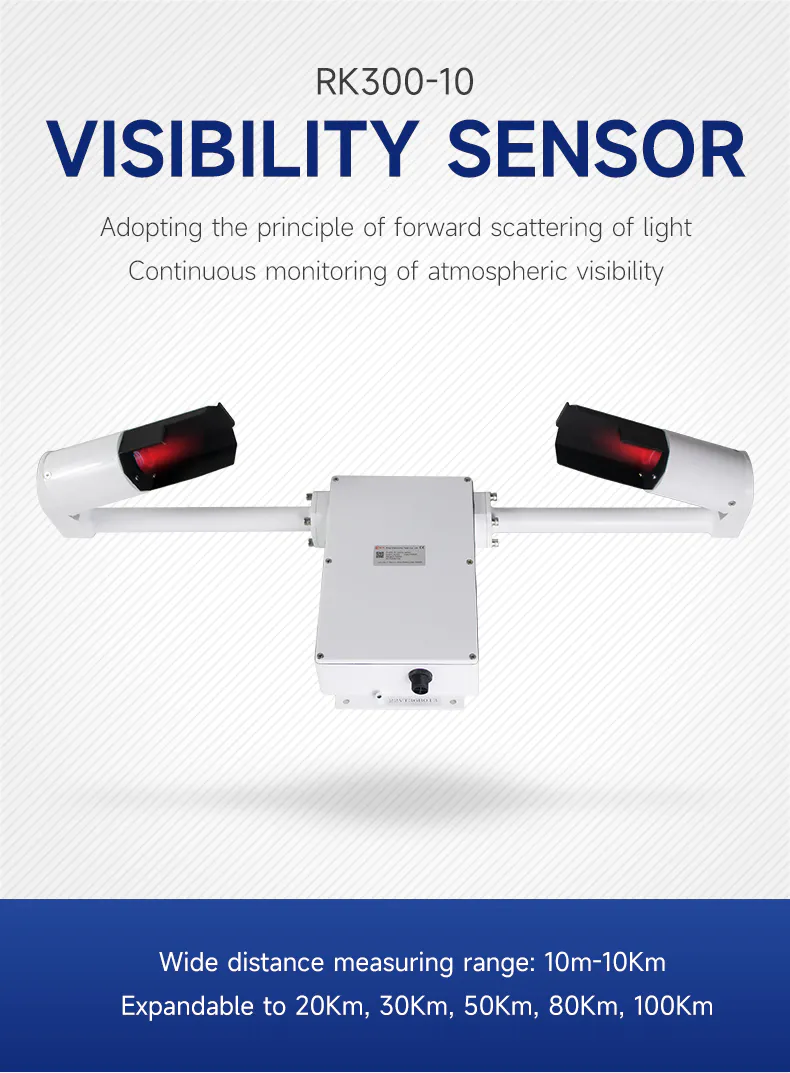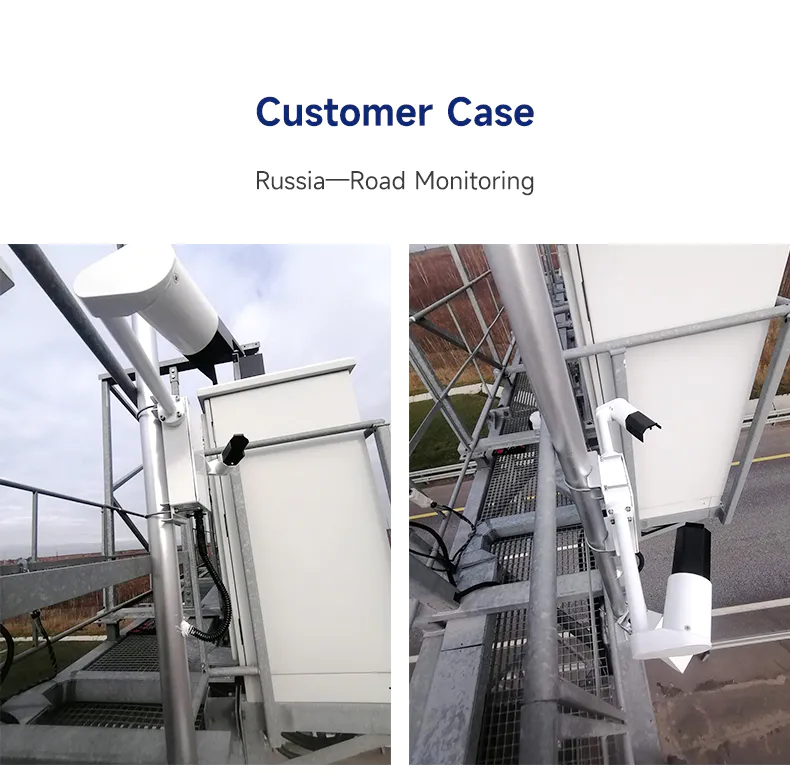Rika Sensor is a weather sensor manufacturer and environmental monitoring solution provider with 10+ years of industry experience.
Maximizing Safety: Understanding Visibility Sensors in Environmental Monitoring
Visibility sensors play a crucial role in environmental monitoring, particularly in ensuring safety across various industries and sectors. These sensors are designed to measure the extent to which objects in the atmosphere can be seen, providing valuable data on visibility conditions. In environments where low visibility poses risks to safety, such as roads, airports, and industrial sites, visibility sensors are indispensable tools for assessing atmospheric conditions and mitigating potential hazards.
Visibility sensors contribute to assessing atmospheric conditions by detecting and quantifying the presence of particles, such as dust, smoke, fog, or haze, that reduce visibility. By continuously monitoring these conditions, visibility sensors provide real-time data that helps decision-makers anticipate and respond to changing visibility levels. This information is essential for implementing appropriate safety measures, such as adjusting traffic flow, issuing warnings, or activating safety protocols to minimize risks to human health and safety.
Different Types of Visibility Sensors
Visibility sensors come in various types, each with its unique design and method of operation. Two common types of visibility sensors are transmissometers and nephelometers, each serving distinct purposes in assessing atmospheric visibility.
• Transmissometers:
Transmissometers measure visibility by emitting a beam of light across a known distance and measuring the amount of light that reaches a receiver. The sensor calculates visibility by analyzing the attenuation, or reduction, of light as it travels through the atmosphere. This attenuation is caused by the scattering and absorption of light by particles such as fog, smoke, or dust. Transmissometers are widely used in aviation and meteorology for monitoring visibility over long distances, such as in airports or along highways.
• Nephelometers:
Nephelometers measure visibility by detecting and quantifying the scattering of light caused by suspended particles in the atmosphere. These sensors emit light at a specific angle and measure the amount of scattered light at various angles. By analyzing the scattering pattern, nephelometers can determine the concentration and size distribution of particles in the air, which directly affects visibility. Nephelometers are commonly used in environmental monitoring and research applications to assess air quality and atmospheric visibility in urban and industrial areas.
Regardless of the type, visibility sensors operate on the principle of detecting and quantifying the interaction between light and particles in the atmosphere. By accurately measuring this interaction, visibility sensors provide valuable data on atmospheric conditions, helping decision-makers assess visibility levels and implement appropriate safety measures to mitigate risks.
Installation and Calibration of Visibility Sensors
Installing and calibrating visibility sensors correctly is essential to ensure accurate and reliable measurements of atmospheric conditions. Here's a step-by-step guide on the proper installation of visibility sensors and the importance of calibration for accurate visibility measurements.
▍ Selecting the Installation Site: Choose a location that represents the area of interest and is free from obstructions that could interfere with visibility measurements, such as buildings, trees, or other structures. Ensure the installation site is level and stable to prevent any movement or shifting of the sensor.
▍ Mounting the Sensor: Follow the manufacturer's instructions for mounting the visibility sensor securely on a stable platform or pole at an appropriate height above the ground. Position the sensor in a way that minimizes the risk of physical damage and maximizes exposure to the surrounding atmosphere.
▍ Aligning the Sensor: Properly align the sensor to ensure it is facing the desired direction for measuring visibility. Adjust the angle and orientation of the sensor according to the manufacturer's specifications to optimize performance.
▍ Connecting Power and Data Cables: Connect the power and data cables of the visibility sensor to the designated ports on the data logger or monitoring system. Ensure all connections are secure and properly insulated to prevent electrical issues or data loss.
▍ Calibrating the Sensor: Perform calibration procedures according to the manufacturer's recommendations to ensure accurate and reliable measurements. Calibration typically involves adjusting sensor settings and parameters to match known reference values or standards. Regular calibration is essential to maintain the accuracy of visibility measurements over time, especially in dynamic environmental conditions.
▍ Testing and Validation: Conduct thorough testing of the visibility sensor after installation and calibration to verify its performance and accuracy. Compare sensor readings with those from nearby reference instruments or official weather stations to validate measurements.
▍ Importance of Calibration: Calibration is crucial for ensuring the accuracy and reliability of visibility sensor measurements. It involves adjusting the sensor's settings and parameters to match known reference values or standards. Properly calibrated sensors provide more accurate data, which is essential for making informed decisions and taking appropriate actions to mitigate risks in environments where visibility is a critical factor for safety. Regular calibration helps maintain the sensor's accuracy over time, ensuring consistent and reliable performance in various atmospheric conditions.
Benefits and Limitations of Visibility Sensors
Visibility sensors offer numerous advantages for environmental monitoring, but they also come with certain limitations and challenges that users should be aware of.
1. Enhanced Safety: Visibility sensors play a crucial role in enhancing safety by providing real-time data on atmospheric visibility. This information helps transportation authorities, airports, and industrial sites make informed decisions to mitigate risks associated with low visibility conditions, such as fog, smoke, or haze.
2. Improved Decision-Making: By continuously monitoring visibility levels, these sensors enable stakeholders to make timely decisions regarding traffic management, flight operations, and outdoor activities. This leads to more efficient resource allocation and improved overall operational efficiency.
3. Environmental Monitoring: Visibility sensors contribute to environmental monitoring efforts by providing data on air quality and particulate matter concentrations. This data is valuable for assessing pollution levels, understanding aerosol dynamics, and implementing pollution control measures.
4. Data Integration: Visibility sensor data can be integrated with other environmental monitoring systems, such as weather stations and air quality sensors, to provide a comprehensive understanding of atmospheric conditions. This integrated approach enhances the accuracy and reliability of environmental assessments.
Limitations and Challenges of Visibility Sensors:
◀. Accuracy Issues: Visibility sensors may encounter accuracy issues under certain environmental conditions, such as extreme weather events or high concentrations of airborne particles. Calibration and maintenance are crucial to mitigate these accuracy issues and ensure reliable measurements.
◀ Sensor Interference: External factors, such as nearby sources of light or electromagnetic interference, can affect visibility sensor performance and accuracy. Proper sensor placement and shielding measures may be required to minimize interference and maintain data integrity.
◀ Maintenance Requirements: Visibility sensors require regular maintenance to ensure optimal performance and longevity. This includes cleaning the sensor components, calibrating the sensor regularly, and monitoring for signs of wear or damage.
◀ Cost Considerations: The initial cost of purchasing and installing visibility sensors, as well as ongoing maintenance and calibration expenses, can be significant. Organizations must weigh these costs against the benefits of improved safety and environmental monitoring.
Conclusion:
In conclusion, Rika Sensor stands at the forefront of environmental and weather monitoring with our extensive experience and dedication to providing high-quality sensor solutions. Our visibility sensors play a critical role in environmental monitoring for safety, ensuring that stakeholders have access to real-time data on atmospheric conditions to make informed decisions and implement proactive measures. With our comprehensive line of weather instruments, including anemometers, barometers, thermometers, rain gauges, soil sensors, water sensors, and accessories, Rika Sensor offers a complete solution for monitoring various environmental parameters.
Our commitment to delivering high-quality products, effective technical support, and advanced project solutions has earned us a strong reputation among customers worldwide. From verifying the performance of green buildings and renewable energy systems to agricultural and coastal research, our weather stations and sensors are widely used in diverse monitoring applications across more than 50 countries and regions.
As we continue to grow and evolve, Rika Sensor remains dedicated to being your close business partner, offering alert and responsive service to meet your needs. We understand and anticipate the challenges you face, and we are committed to providing innovative solutions to enhance safety, efficiency, and decision-making in environmental monitoring. Thank you for choosing Rika Sensor as your trusted partner in environmental monitoring solutions.
Rika RK300-10 Visibility Sensor

LEAVE A MESSAGE








